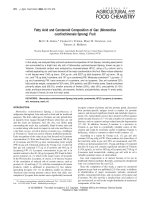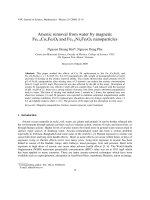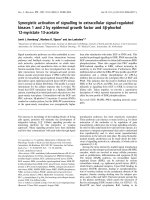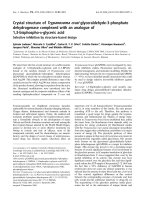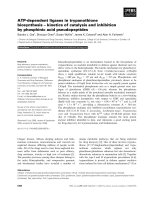Separation of acetic acid and water by distillation effect of calcium chloride addition
Bạn đang xem bản rút gọn của tài liệu. Xem và tải ngay bản đầy đủ của tài liệu tại đây (451.26 KB, 4 trang )
April
1950
INDUSTRIAL
AND
ENGINEERING CHEMISTRY
727
LITERATURE CITED
(1)
Guertler,
W.,
and Liepus,
T.,
2.
Metallkunde,
17, 310-5 (1925).
(2)
Harned,
H. S.,
and
Davis,
R.,
Jr.,
J.
Am.
Chem.
SOC.,
65,
2030-7
(1943).
(3)
Hothersall,
A.
W.,
and Gardam, G.
E.,
J.
Electrodepositow’
Tech.
SOC.,
15,
127-40 (1939).
(4)
McKay,
R.
J.,
IND.
ENG.
CHEM.,
21,
1283-7 (1929).
(5)
McKay, R.
J.,
and Worthington, R., “Corrosion Resistance
of
Metals and Alloys,”
p.
369,
New
York,
Reinhold Publishing
Corp.,
1936.
(6)
Mellor,
J.
W.,
“A
Comprehensive Treatise on Inorganic and
Theoretical Chemistry,” Vol.
XV,
p.
156,
London, Longmans,
Green
&
Co.,
1936.
(7)
Mitchell,
A. M.,
with Mellon, M.
G.,
IND.
ENG.
CHEEK.,
ANAL.
ED., 17, 380-2 (1945).
(8)
Miiller,
E.,
and Luber,
A.,
2.
anorg.
allgem.
Chem.,
187, 209-30
(1930).
(9)
Pinner,
W.
L., Soderberg,
G.,
and Baker,
E.
M.,
“Modern Elec-
troplating,”
p.
242,
New
York, Electrochemical Society, Inc.,
1942.
(10)
Robl,
R.,
2.
angew.
Cha.,
37, 938-9 (1924).
(11)
Sohlatter, Max,
U.
5.
Patent
1,972,693
(Sept.
4,
1934).
(12)
Uhlig,
H.
H.,
ed., “Corrosion Handbook,”
p.
254,
New York,
(13)
Wesley,
W.
A.,
and Copson, H.
R.,
J.
Electrochem.
Sac.,
95,
226-
(14)
Young, C.
B.
F.,
Proc.
Am.
Electroplaters’
Soc.,
28,
124-35
John Wiley
&
Sons, Inc.,
1948.
41 (1949).
(1940).
RECEIVED
August
22,
1949.
Separation
of
Acetic
Acid and
__
Water
by
Distillation
J
EFFECT OF CALCIUM CHLORIDE
ADDITION
LEO GARWIN
AND
KENTON
E.
HUTCHISONl
Oklahoma Agricultural
and
Mechanical College, Stillwater, Okla.
ECAUSE acetic acid
B
and water are not
too
readily separated by ordi-
nary distillation, methods
involving auxiliary tech-
niques have been used for
some time. These methods
include
(10)
azeotropic
distillation with
a
water-
Experimental data are presented
on
the vapor-liquid
equilibrium
of
the system acetic acid-watercalcium
chloride at
1
atmosphere. These data were obtained with
a view
to
ascertaining the possibility
of
separating acetic
acid and water under conditions
of
reversed relative vola-
tility
by
extractive distillation with calcium chloride.
The results show a considerable effect
of
calcium chloride
addition, with a reversal taking place at approximately
8
weight
calcium chloride in the liquid phase.
immiscible organic com-
pound such as butyl acetate
(Othmer process),liquid-liquid extraction with ethyl ether or ethyl
acetate, followed by the removal of the solvent from the extract by
fractional distillation, and simple extractive distillation (without
reflux) using a wood oil
(Suida process). In the last-named
method, the water is removed overhead and the acetic acid-wood
oil bottoms mixture is separated by
a
second distillation under
vacuum.
The aqueous acetic acid solution to be separated is very fre-
quently
a
dilute one, and
it
was thought worth while to investigate
further the separation of the components of such a mixture by an
extractive distillation process in which the acetic acid would be
taken overhead and the bulk
of
the mixture (water) would be re-
moved as bottoms. In order to do this-i.e., reverse the normal
relative volatility
of
acetic acid and water-it would be necessary
to use,
as
the extractive distillation agent, a substance which
would tend to form
a
loose combination with the water. Inor-
ganic salts seemed to offer good prospects for this purpose.
McBain and Kam
(6)
reported some work on the distillation of
dilute solutions of acetic acid in water in the presence of lithium
chloride, sodium chloride, potassium chloride, potassium thiocya-
nate: sodium sulfate, potassium nitrate, and sodium acetate.
Quartaroli
(9)
did a somewhat similar study with sodium chlo-
ride, lithium chloride, calcium chloride, and sodium bromide.
Calculations based on the data of these investigators showed that,
of
the
salts
posseseing commercial possibilities, lithium chloride,
calcium chloride, and sodium chloride were the most effective,
with expected relative volatility reversals taking place in dilute
1
Present address, Kerr-McGee
Oil
Industries,
Ino.,
Oklahoma
City,
Okla.
acetic acid solution at
about
6.5
weight
%
lithium
chloride,
10
weight
%
cal-
cium chloride, and
12
weight
%
sodium chloride.
In order for this relative
volatility reversal to take
place throughout the distil-
lation column, it is neces-
sary that the extractive dis-
tillation agent be present
in the liquid in the proper concentration on all of the trays of
the column. That is to say, it must be soluble in glacial acetic
acid as well as in water. Semiquantitative solubility studies
by
Davidson
(1)
show sodium chloride and potassium chloride to
be rather insoluble in glacial acetic acid.
On
this basis, it might
be expected that lithium chloride,
an
alkali chloride, would also be
insoluble. Calcium chloride, however, is quite soluble in acetic
acid and data for its solubility as a function of temperature
(6)
are given in Figure
1.
It
was selected, therefore, as the salt
for
further investigation.
EXPERIMENTAL
A11
chemicals used in this work were analytical reagent grade.
The glass, electrically-heated equilibrium still employed was es-
sentially the one described by Jones, Schoenborn, and Colburn
(C),
but modified in the following respects:
The condensate chamber was filled with glass beads to reduce
its volume relative
to
that
of
the residue chamber
to
the greatest
possible extent. During operation the condensate-residue volume
ratio was about
1
to
4.
A
wick of glass wool was substituted for the wire helix in the
flash boiler. This permitted better distribution
of
the distillate
over the boiler heating surface, avoiding local overheating, and
minimizing the danger of the
glass
cracking.
The pressure on the still was maintained at
760
*
0.5
mm. by
means of
a
Model
No.
5
industrial Cartesian manostat (The
Emil
Greiner Company), actuated by compressed nitrogen gas from
a
cylinder.
128
INDUSTRIAL AND ENGINEERING CHEMISTRY
Vol.
42,
No.
4
25
50
75
TEMPERATURE,
OC.
Solubility of Calcium Chloride
Figure
1.
in Glacial Acetic Acid
Menschutkin
(6)
The
temperature
of
the
boiling
liquid
in
the
residue chamber
was
measured
to
0.1"
C.
with
a
mercury
thermometer
inserted
in
a
thermometer
well.
Glycerine
was
used
as
the
contact
fluid.
The
thermometer
was
checked
and
found
to
be
accurate
at
the
100'
C.
point
by
making
a
trial
run
with
distilled
water.
The
experimental
runs
were
designed
to
cover the complete
range
of
water-acetic
acid
ratios
with
calcium
chloride
concentra-
tions
varying
from
zero
to
the
maximum
possible
value,
this
limit
being
determined
by
the solubility
of
the
salt
in
the
liquid.
Be-
TABLE
I.
VAPOR-LIQUID
EQUILIBRIUM
AND
BOILING
POINT
DAT-4
FOR
ACETIC
ACID-WATER-CALCIUM
CHLORIDE
SYSTEM
(Pressure,
760
mm.
€Ig)
m't.
%
Run
No.
S
X
Y
T,
C.
.
1A
2A
3E
4A
5A
6A
7
8
9
10
11
12
13
14
15
16
17
18A
19
20
21
22
23
25A
26
27
28
29A
30
31
32
33
34
36
37
38
39
40
0.0
0.0
0.0
0.0
0.0
0.0
9.3
10.1
9.7
9.4
9.6
9.5
19.7
19.3
20.0
19.8
19.0
18.4
29.8
29.2
31.0
30.4
31.6
37.6
40.1
35
6
39.1
36.8
36.2
44.7
45.1
45.8
49.5
53.4
53.2
60.3
60.5
61.0
91.9
74.5
61.9
44.2
23.6
10.6
85.3
76.5
62.5
41.3
26.5
11.8
88.8
79.2
66.8
45.1
28.1
15.3
93.5
83.6
79.8
48.7
32.1
91.0
86.0
71.7
55.1
36.5
18.4
84.8
73.4
57.1
90.4
88.6
97.0
98.5
91.2
85.5
93.9
81.5
71.9
56.5
34.6
17.4
83.7
73.5
59.7
39.6
25.4
11.5
79.9
65.7
49.4
30
2
18.8
11.0
81.5
59.7
51.3
25.0
16.0
67.8
50.8
39.2
25.4
16.4
7.2
47.8
48.6
33.0
20.0
51.8
47.5
65.0
80.7
50.8
100.2
100.9
101.3
101.9
104,
-1
108.0
102.0
102.4
103.2
105.0
107.6
111.6
104.2
104.8
106.2
109.0
112.0
115.0
110.0
110.2
111.1
115.0
120.3
113.3
116.8
114.0
118.9
121.6
127.2
121.2
120.9
121.9
128.0
127.
I)
127.5
132.3
138.9
136.0
~~~ ~ ~~
cause
calcium
chloride
is
more
soluble
in
water
than
in
acetic
acid,
it
was
possible
to
go
to
as
high
as
60
weight
%
salt
in
the
water-
100
I
I
I I
I
I
I
I
__
OTHMER
a
GILMONT
(7)
-___
PERRY
(8)
__
THIS
INVESTIGATION
-
80
-
0
0
0.
4
'
60-
f
K
w
l-
;
I
t-
40-
i5
-
w
e
20
-
I
I
I
I
1
I
I
I
I
20
40
60
80
100
0
WEIGHT
%
WATER
IN
LIQUID
Figure
2.
Vapor-Liquid Equilibrium Behavior
of
Acetic Acid-Water
System
Pressure,
760
mm.
Hg
iich
region
but
only
to
about
30
weight
%
in
the
acid-rich
range.
For
any
particular
run,
the
acetic
acid-water
mixture
of
the
approximate
proper
concentra-
tion
was
introduced
into
the
condensate
chamber.
Another
portion,
to
which
the
neces-
sary
amount
of
anhydrous
calcium
chloride
had
been
added,
was
introduced
into
the
residue chamber.
The
still
was
allowed
to
operate
for
3
hours
before
the
taking
of
sam-
ples.
Preliminary
tests showed that 3
hours
were
ample,
even
without
the
glass
beads
in
the condensate
chamber.
AsALyTlc-4~
METHODS.
The
condensate,
which
was
considered
to
consist
of
acetic
acid
and
Jvater,
was
analyzed
for
the
acid
by
titra-
tion
v,ith
standard
sodium
hydroxide,
using
phenolphthalein
as
the
indicator.
The
residue,
when
it
contained calcium
chloride,
was
first
titrated
for
acetic
acid
con-
tent
as
described
above.
It
was
found
that
the
presence
of
calcium
chloride had
no
effect
on this
titration.
The
sample thus
titrated
was
titrated
further
for
chloride
content with
silver
nitrate,
using
sodium
chromate
as
the
indicator
(Mohr's
method)
(6).
It
was
only
necessary,
prior
to
this
second
titration,
t:
dis-
charge
the
caustic-phenolphthalein
end point
color
with
a
fraction
of
a
drop
of
acetic
acid.
This
method
of
determining chloride
in
the
presence
of
sodium
acetate
and
phenolphtha-
lein
indicator
was
found
quite
satisfactory
by
a
series
of
test
analyses
on
known
mixtures.
All
analytical determinations
were
made
in
duplicate;
average
values
are
reported.
good.
150
-
8
I
Complete smoothed vapor-liquid equilib-
rium data are given in Table
I11
and are
plotted in Figure
3.
The number adjacent
140
-
LINES
OF
CONSTANT
WT
%
CoClp
to each experimental point in the figure rep-
resents the calcium chloride content of the
liquid to the nearest weight per cent. The
/i
60
XI0
+
the experimental points for approximately
-
Pressure,
760
mm.
HE
730
INDUSTRIAL
AND
ENGINEERING CHEMISTRY
Vol.
42,
No.
4
TABLE
111.
SMOOTHED VAPOR-LIQUID
EQUILIBRIUM
ARD
BOIL-
ING
POINT
DATA
FOR
ACETIC ACID-WATER-CALCIUM CHLORIDE
SYSTEM
(Pressure, 760
mm.
Hg)
S
0.0
0.0
0.0
0.0
0.0
0.0
0.0
0.0
0.0
0.0
0.0
10.0
10.0
10.0
10.0
10.0
10.0
10.0
10.0
10.0
10.0
10.0
20.0
20.0
20.0
20.0
20.0
20.0
20.0
20.0
20.0
20.0
20.0
5.0
10.0
20.0
30.0
40.0
50.0
60.0
70.0
80.0
90.0
95.0
5.0
10.0
20.0
30.0
40.0
50.0
60.0
70.0
80.0
90.0
95.0
5.0
10.0
20.0
30.0
40.0
50.0
60.0
70.0
80.0
90.0
95.0
8.5
16.5
30.3
41.8
52.5
62.2
70.7
78.2
85.5
92.8
96.3
4.5
9.0
18.2
27.6
37.2
46.8
56.8
67.0
77.5
88.2
93.8
3.3
6.5
13.0
19.6
26.2
33.7
42.3
53.2
67.0
81.6
90.0
T,
C.
111 .0
108,2
105.1
103.4
102.3
101.7
101.2
100.8
100,5
100.2
100.0
109.3
107.0
105.4
104.2
103.5
102,8
102.3
102.0
101.8
iii:~
,
ii4:6
112.1
110.1
108.4
107.0
105.9
104.9
104,4
104.5
S
30.0
30.0
30.0
30.0
30.0
30.0
30.0
30.0
30.0
30.0
30.0
40.0
40.0
40.0
40.0
40.0
40.0
40.0
40.0
50.0
50.0
50.0
50.0
50.0
60.0
60.0
60.0
60.0
60.0
ii
5,0
10.0
20.0
30.0
40.0
50.0
60.0
70.0
80.0
90.0
95.0
30.0
40.0
50.0
60.0
70.0
80.0
90.0
95.0
60.0
70.0
80.0
90.0
95.0
90.0
92
5
95.0
97.0
99.0
.,
“t.
%
Y
r_
2.4
4.9
10.0
15.1
20.6
26.5
33.8
42.6
53.6
71.5
84.5
12.0
16.5
21.7
27.7
35.0
44.6
61,5
76.5
21.0
26.9
36.5
53.2
69.0
46.5
52.0
59
2
67.0
81.0
T,
C.
ii9:0
116.8
114.5
112.8
111.5
110.6
110.2
110.3
125.0
122.1
120.0
118.3
116.9
116.3
117.0
117.8
127,5
125,s
124.8
125.1
126.2
134.7
135.0
136.5
138.0
140.0
because
of
the lack
of
available data on the boiling points
of
solu-
tions of calcium chloride in glacial acetic acid.
CONCLUSIONS
The results confirm the observation of Quartaroli
(9)
that the
addition of calcium chloride tends to reverse the relative volatility
of
acetic acid and water. The reversal takes place at about
8
weight
%
calcium chloride in the liquid phase and it is possible,
by the addition of moderate quantities of calcium chloride, to
obtain a reversed relative volatility which is greater in magnitude
than that for the ordinary distillation.
In order to explore fully the potentialities of such a separation
process, further
work
on the continuous extractive distillation
a>-
pect will be required.
NOMENCLATURE
S
=
weight per cent calcium chloride in liquid
T
=
temperature,
C.
X
=
weight per cent water in liquid (salt-free basis)
Y
=
weight per cent water in vapor
LITERATURE CITED
(1)
Davidson,
A.
W.,
J.
Am.
Chem.
Soc.,
50,
1890 (19238).
(2)
Hall,
11‘.
T.,
“Textbook
of
Quantitative Analysis,”
pp.
150-1,
(3)
“International Critical Tables,”
Vol.
111,
p. 325,
New
York,
(4)
Jones,
C.
il.,
Schoenborn,
E.
M.,
and Colburn,
A.
P.,
IND.
Ex
(5) McBain,
J.
W.,
and Kam,
J.,
J.
Chem.
Soc.,
115,
1332 (1919).
(6)
Menschutkin, B.
N.,
2.
anorg.
Chem.,
54,
89 (1907).
(7)
Othmer, D.
F.,
and
Gilmont,
R.,
IND.
EXG.
CHEY.,
36,
1061
(8)
Perry,
J.
H.,
ed.,
“Chemical Engineers’ Handbook,”
p.
1360,
(9)
Quartaroli,
A.,
Ann.
chim.
applicata,
33,
141 (1943).
New York, John Wiley
&.
Sons, Inc., 1941.
McGraw-Hill Book
Co.,
1928.
CHEX,
35,
666
(1943).
(1944).
New
York,
McGraw-Hill
Book
Co., 1941.
(10) Shrew,
R.
N., “Chemical Process Industries,”
pp.
682-8, New
York, McGraw-Hill
Book
Co.,
1945.
RECEIVED
July 27, 1949. Presented
before
the
Oklahoma State Meeting
of
the American Institute
of
Chemical Engineers, Stillwater, Okla.,
November
12,
1949.
Sa
te
CARL
J.
MALM, LEO
J.
TANGHE,
AND
GLENN
D.
SMITH
Eastman
Kodak
Company,
Rochester,
!V.
Y.
Salt effect is a measure of the increase in viscosity of
cellulose acetate caused by the presence of certain salts.
A
procedure
for
the
measurement
of
the salt effect has
been developed. The influence of
salts
on viscosity de-
pends on: the nature of the salt;
amount
of
salt;
pH
of
the solution from which
the
salt
is
applied; solvent
for
the
cellulose acetate in solution; degree
of
hydrolysis of cellu-
lose acetate; and the amounts of carboxyl and combined
sulfate
in
the cellulose acetate.
HE
term “salt effect” is used in this paper to designate the
T
ratio of the viscosity
of
one portion
of
a
cellulose acetate
washed with water containing a certain salt
to
the viscosity
of
a
second portion
of
the same acetate washed with salt-free water
or with water containing
a
salt known
to
have no effect on the
viscosity. In general, salts
of
monovalent cations-e.g., sodium
chloride-are without effect on the viscosity, whereas salts of
polyvalent cations-e.g., calcium chloride-increase the vis-
cosity.
This behavior
was
observed in cellulose acetate by Rogovin
(8)
who found
a
salt effect in acetone but not in formic acid.
Lohmann
(6)
has studied the salt effect in
a
variety
of
solvents
and found that it was manifested especially in concentrated
solutions in solvents such
as
ketones
and
esters which do not
contain hydroxjl groups. The salt effect
in
acetone was reduced
by the addition
of
water or methanol. High viscosity, due
either to high solids content or to high molecular weight of the
cellulose acetate, increased the effect.
He
observed the salt
effect mainly Kith calcium chloride and found that it increased
with the amount of salt added. An especially significant observa-
tion
was
that the increased viscosity
of
cellulose acetate due to
certain salts did not add to the tensile strength of fibers spun
from
these solutions.
Other findings in this field have been that the salt effect was
more pronounced with products made from wood pulp than from
cotton linters
(4).
Also, it increased with the degree
of
hydrolysis
of
the cellulose ester
(3)
and with the pH
of
the wash solution
from which the salts are applied
(7).
Lohmann’s finding that the increased viscosity due to
salts
failed to give
a
corresponding increase in the yarn strength makes
this increase in viscosity undesirable. With this background an
investigation
was
undertaken to develop
a
procedure for measur-
ing salt effect and
to
establish factors responsible
for
the effect.
First, several of the above observations were verified using
production batches
of
yarn-type cellulose acetate containing
approximately
39%
acetyl. Table
I
gives the effect
of
various
salts on the viscosity
of
this type of cellulose acetates. The
acetates of the alkaline earth elements all gave about the same


